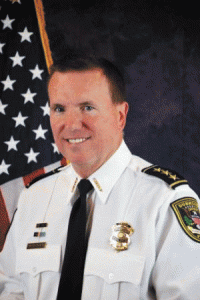Editor’s note: the following is a guest column written by Dunwoody Police Chief Billy Grogan. It appeared in the May 3 edition of Reporter Newspapers.
During the recent terrorist attack in Boston, I was following the developments with concern as they unfolded on live television, as was most of America. The questions and the eventual hunt for those responsible dominated the 24/7 news cycle of the major cable news channels. Unfortunately, much of the information being pushed out was conjecture and speculation sprinkled with outright untruths and false information.
In addition, there seemed to be information overload.
Fortunately, the Boston Police Department utilizes social media to communicate with its citizens. In this case, the department’s Twitter channel became the go-to source for accurate and timely information.
Law enforcement began using social media several years ago, and today that use has skyrocketed. Agencies, both large and small, recognize the value of using social media to communicate with its citizens, promote their department, create a two way dialogue, by-pass the media filter, and disseminate timely information in the event of a real-time crisis.
Of course, most of the information disseminated by police agencies about real-time events is not as critical as the Boston bombing, nor do the routine events garner such national attention. Nonetheless, the information about these local events is still of value to the community.
The Dunwoody Police Department began using social media the day we began operations as a police department on April 1, 2009. Since that first day, our use of social media has expanded and our engagement with the community using social media has increased tremendously. On a daily basis, we push out information about real-time events such as traffic accidents, road closures, suspects we may be searching for and other information which may affect our community or where the community could assist our department.
Currently, the Dunwoody Police Department is a leader in police department’s use of social media. We have 2,700 likes on Facebook, 74 subscribers on YouTube and 4,634 followers on Twitter. We also use the social media platform Interactive Defense to connect about 1,800 citizens within our neighborhoods.
In the Boston bombing case, the Boston Police Department, through their Twitter account @Boston_Police, provided timely updates throughout the developing investigation and manhunt after the bombing.
Two posts on Twitter stand out as excellent.
The first was after CNN and other news channels erroneously reported the arrest of a suspect. A tweet from the Boston Police read as follows: “Despite reports to the contrary there has not been an arrest in the Marathon attack.”
The second post was made during the intensive manhunt. The media were everywhere filming the police, and the following tweet was sent by the Boston Police: “#MediaAlert: WARNING: Do Not Compromise Officer Safety by Broadcasting Tactical Positions of Homes Being Searched.” This tweet was re-tweeted over 20,000 times. The Boston Police Department’s Twitter followers increased from about 40,000 to over 317,000 during this crisis.
Of course, this was not the first incident where social media was used by law enforcement in a crisis of great magnitude. In 2010, the Vancouver Police Department created a Facebook page to help identify the suspects in the Olympic Riot. And in 2011, the same department created a blog to help identify the Stanley Cup Rioters. However, the media coverage and scrutiny of these incidents paled in comparison to the Boston bombing.
Fortunately, events such as the Boston Marathon Bombing are extremely rare. Unfortunately, the thirst for information exhibited by both the media and the public is far too common.
In cases like this, where real-time events are unfolding and information may be needed by investigators or safety alerts may need to be provided, the police departments involved are your best and most accurate source of information. The police departments do their level best not to disseminate information unless they know it is accurate. In addition, they try to avoid alarming citizens unnecessarily.
The @Boston_Police department, @FBIBoston and the @MassStatePolice all used social media-particularly Twitter-to inform, solicit information and to correct false and misleading information.
In fact, the Boston Police Department continues to provide information in the aftermath of the Boston Marathon Bombing. The department recently tweeted information for those who left their personal property behind when they fled the area of the bombing on how to retrieve their items.
Billy Grogan is chief of police for the city of Dunwoody.

